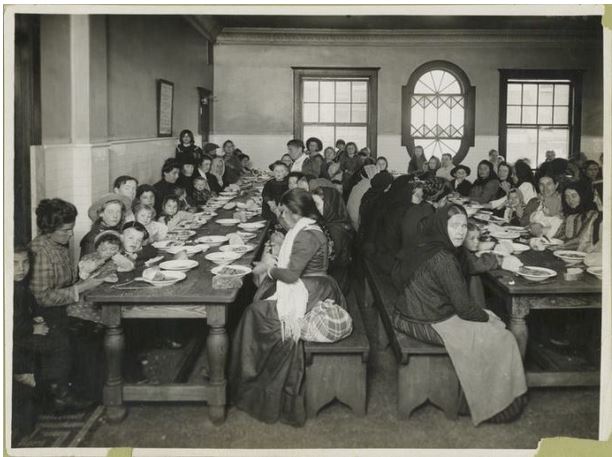 | ||||||||||
| Ellis Island, foreground |
"From 1892 to 1954, over 12 million immigrants entered USA through the portal of Ellis Island in New York Harbor...."It is estimated that 40% of all current U.S citizens can trace at least one ancestor to Ellis Island....The ‘Passage of Immigrant Quota Act’ of 1921 ended the era of mass immigration to New York....During the peak period of Ellis Islands operations between 1900 and 1914, 5,000 to 10,000 passed through the immigration station each day."....
 |
| Ellis Island arrivals |
"Ellis Island Immigration Museum is part of the Statue of Liberty National Monument and is under the care of the National Park Service. For many, Ellis Island is one of the most meaningful historic sites in New York. Visitors can easily spend hours here learning about America’s immigration history and the varied roles the island has played since the nation’s early years....

"Guided 90-minute tours will take you to select areas of the 750-bed Ellis Island Hospital. Visit the Laundry Building, with much of its original equipment still in place, where over 3000 pieces of laundry were washed and sanitized daily, infectious and contagious disease wards, kitchen, staff housing, autopsy room and more."
"Ellis Island Facts"
"Did you know?"
"Some say that Ellis Island was the ‘gateway to the American dream’ but what we do know for a fact is that it was the gateway to America for 60 years.…
Ellis Island was opened in 1892 as a Federal Immigration station, a purpose it served for 60 years. Millions of immigrants passed through the station many from eastern and southern Europe and many were escaping poverty and conflict.
A Journey Before the Journey
Typically starting on horseback or train from cities and towns across Europe, many travelers had a long journey just to get to the seaport. They then boarded ships that were crowded, filled with a diverse group of up to 3,000 passengers all from different cultures and religions, and trekked across the Atlantic for 2 weeks.
Conditions Onboard the Steamships
Passengers were dispersed between first class, second class and steerage, according to wealth of each passenger. The contrast between first and second classes meant that those with greater wealth enjoyed staterooms and cabin whilst steerage was just an open space at the bottom of the boat.
Tracing Ancestry
It is estimated that 40% of all current U.S citizens can trace at least one ancestor to Ellis Island....
Eating at Ellis Island
 |
| SaveEllisIslandFacts |
Free meals were served on the island and a typical meal could include beef stew, potatoes, bread, herrings, baked beans and stewed prunes. There were also independent concessions that sold packaged food to be bought as people waited or to take with them when they left the island....
Peak Time of Arrivals
During the peak period of Ellis Islands operations between 1900 and 1914, 5,000 to 10,000 passed through the immigration station each day. The ‘Passage of Immigrant Quota Act’ of 1921 ended the era of mass immigration to New York."
images above from Save Ellis Island
-------------------
Added: "Immigration Act of 1921" was passed to protect American culture and wages of American workers already living in the US:
"Immigration Act of 1921," immigrationtounitedstates.org, Kimberly K. Porter
"Also known as: Johnson Act; Emergency Quota Act of 1921"
"Significance: The first federal law in US history to limit the immigration of Europeans, the Immigration Act of 1921 reflected the growing American fear that people from southern and eastern European countries not only did not adapt well into American society but also threatened its very existence.
The law specified that no more than 3 percent of the total number of immigrants from any specific country already living in the United States in 1910 could migrate to America during any year.
Although concerns about undesirable immigration to the United States had been discussed for decades, and action had been taken to prevent the immigration of most Asians, fears springing out of the aftermath of World War I again bestirred those who would close the floodgates of immigration.
According to federal officials scattered throughout European consulates, literally millions of Europeans hoped to emigrate to the United States in the aftermath of World War I (1914-1918). Some of these would-be immigrants could be considered as coming from the "desirable” classes of western and northern European nations, but it appeared that the vast majority of the potential immigrants would be coming from southern and eastern Europe.
Many Americans held the perception that individuals from southern and eastern Europe could not be assimilated properly into the culture of the United States. Their languages, customs, and religions were thought to be too different from those of preceding generations of immigrants for full scale integration into American culture. The fear was that these newer immigrants would always be "hyphenates,” or citizens who would call themselves, or be called by others, by such hyphenated names as "Polish-Americans,” "Greek-Americans,” and "Italian-Americans.”
Beyond the fear of being swamped by unassimilable immigrants from eastern and southern Europe was the fear that these immigrants’ increasing numbers would depress wages for American workers. In addition, some people feared the potential of the rising political power of the new class of immigrants.
..................
.............................


No comments:
Post a Comment